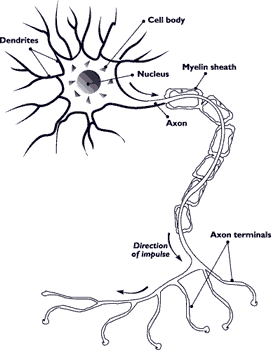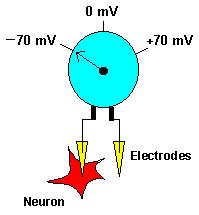CIDPUSA.org Guide Autoimmune diseases
Nerve Physiology-1
A nerve cell is called a neuron and it transmits its messages by the axon.
The nucleus of a neuron is located in the cell body. Extending out from theThe nucleus of a neuron is located in the cell body. Extending out from the cell body are processes called dendrites and axons. These processes serve to conduct impulses (with dendrites conducting impulses toward the cell body and axons conducting impulses away from the cell body).

Neurons can respond to stimuli and conduct impulses because a membrane potential is established across the cell membrane. In other words, there is an unequal distribution of ions (charged atoms) on the two sides of a nerve cell membrane. This is illustrated with a voltmeter:

With one electrode placed inside a neuron and another outside, the voltmeter is 'measuring' the difference in the distribution of ions on the inside versus the outside. And, in this example, the voltmeter reads -70 mV (mV = millivolts). In other words, the inside of the neuron is slightly negative relative to the outside. This difference is referred to as the Resting Membrane Potential. How is this potential established? ting membrane Potential Please continue to next page
Contact CIDPUSA.org through services section link on home page. Search this web site 5000 pages